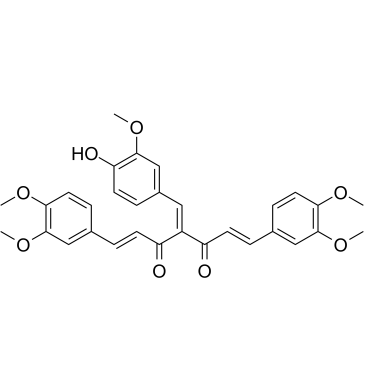| Cas No.: | 1227098-15-8 |
| Chemical Name: | (1E,6E)-1,7-Bis(3,4-dimethoxyphenyl)-4-(4-hydroxy-3-methoxybenzylidene)hepta-1,6-diene-3,5-dione |
| Synonyms: | (1E,6E)-1,7-bis(3,4-dimethoxyphenyl)-4-(4-hydroxy-3-methoxybenzylidene)hepta-1,6-diene-3,5-dione;BDBM50484021;1,7-Bis(3,4-dimethoxyphenyl)-4-(4-hydroxy-3-methoxybenzylidene)hepta-1,6-diene-3,5-dione;NF-κB-IN-1 |
| SMILES: | O(C([H])([H])[H])C1=C(C([H])=C([H])C(=C1[H])/C(/[H])=C(/C(/C(/[H])=C(\[H])/C1C([H])=C([H])C(=C(C=1[H])OC([H])([H])[H])OC([H])([H])[H])=O)\C(/C(/[H])=C(\[H])/C1C([H])=C([H])C(=C(C=1[H])OC([H])([H])[H])OC([H])([H])[H])=O)O[H] |
| Formula: | C31H30O8 |
| M.Wt: | 530.5651 |
| Purity: | >98% |
| Sotrage: | 2 years -20°C Powder, 2 weeks 4°C in DMSO, 6 months -80°C in DMSO |
| Description: | NF-κB-IN-1, a 4-arylidene crucumin analogue, is a potent NF-κB signaling pathway inhibitor. NF-κB-IN-1 directly inhibits IKK to block NF-κB activation. NF-κB-IN-1 effectively inhibits the viability of lung cancer cells and attenuates the clonogenic activity of A549 cells. |
| Target: | IKK[1] |
| In Vitro: | NF-κB-IN-1 (compound 17) (0.001-100 μM; 72 h) inhibits the growth of A549, H1944, H460 and H157 cells, with GI50s of 0.72, 0.07, 0.13, and 0.16 μM, respectively[1]. NF-κB-IN-1 (0.5-25 μM; pretreated for 30 min or 4 h) potently blocks the IκB phosphorylation and degradation in A549 cells[1]. NF-κB-IN-1 (0.1-100 μM; pretreated for 30 min) dose-dependently inhibits the TNFα-induced nuclear translocation of NF-κB in A549 cells, with an IC50s of 1.0 μM[1]. NF-κB-IN-1 (0.1-0.4 μM; 9 d) inhibits lung cancer clonogenic activity[1]. Cell Viability Assay[1] Cell Line: A549, H1944, H460 and H157 cells Concentration: 0.001, 0.01, 0.1, 1, 10, 100 μM Incubation Time: 72 hours Result: Decreased viability of lung adenocarcinoma cells A549 and H1944, quamous cell carcinoma cells H157, and large cell carcinoma cells H460 in a dose-dependent manner. Western Blot Analysis[1] Cell Line: A549 cells Concentration: 0.5, 1.0, 2.5, 5.0, 10.0, 25.0 μM Incubation Time: Pretreated for 30 min or 4 h Result: Blocked IκB phosphorylation, with an IC50 of 2.8 μM. Blocked IκB degradation in a dose-dependent manner. |
| References: | [1]. Qiu X, et, al. Synthesis and identification of new 4-arylidene curcumin analogues as potential anticancer agents targeting nuclear factor-κB signaling pathway. J Med Chem. 2010 Dec 9;53(23):8260-73. |

 To enhance service speed and avoid tariff delays, we've opened a US warehouse. All US orders ship directly from our US facility.
To enhance service speed and avoid tariff delays, we've opened a US warehouse. All US orders ship directly from our US facility.




















